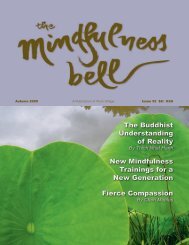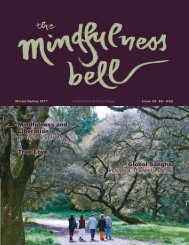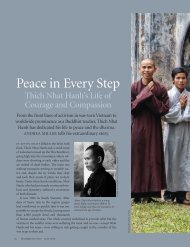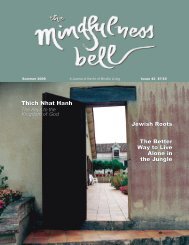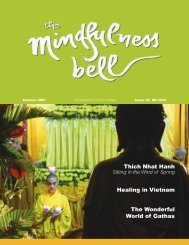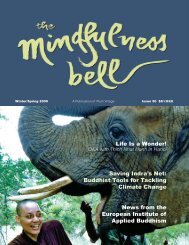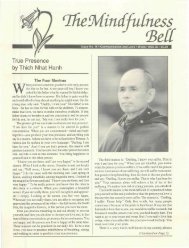View full issue in PDF - The Mindfulness Bell
View full issue in PDF - The Mindfulness Bell
View full issue in PDF - The Mindfulness Bell
- No tags were found...
You also want an ePaper? Increase the reach of your titles
YUMPU automatically turns print PDFs into web optimized ePapers that Google loves.
dhar ma TALK<br />
Our practice is to water those seeds <strong>in</strong> us, to create an environment<br />
around us that gives us a chance of be<strong>in</strong>g a real human be<strong>in</strong>g. What I’m<br />
try<strong>in</strong>g to do with this practice is to cultivate my best self, the best Larry<br />
possible. And when I do that I manifest the way of the bodhisattva. A<br />
bodhisattva is another name for a real human be<strong>in</strong>g. Thay told a story<br />
this summer about a wonderful woman from Holland that he met who<br />
saved thousands of Jews from the gas chambers <strong>in</strong> World War II, all<br />
by herself. Bodhisattvas are real people. Recently I started th<strong>in</strong>k<strong>in</strong>g<br />
photo by Suzanne Anderson<br />
If you<br />
want to do<br />
someth<strong>in</strong>g<br />
with your<br />
life, be a<br />
real human<br />
be<strong>in</strong>g.<br />
about a brief encounter I once had with Mart<strong>in</strong> Luther K<strong>in</strong>g; he was a<br />
real human be<strong>in</strong>g. Mother <strong>The</strong>resa, whom I met when I lived <strong>in</strong> Calcutta,<br />
was a real human be<strong>in</strong>g. She was so real that when she thought<br />
someth<strong>in</strong>g, you just did it. [Laughter.] It was astound<strong>in</strong>g!<br />
Thay is that way. Peggy and I had promised Thay last year that we<br />
would jo<strong>in</strong> him on a trip to Korea last spr<strong>in</strong>g. But as April approached,<br />
we were mov<strong>in</strong>g from one side of the country to the other and we<br />
were extremely busy. So we wrote Thay a beautiful letter say<strong>in</strong>g why<br />
we couldn’t come to Korea. We got a note back: “Thay is very sad.<br />
Here’s the schedule <strong>in</strong> case you change your m<strong>in</strong>d.” [Laughter.] That’s<br />
all a real human be<strong>in</strong>g has to do. Be<strong>in</strong>g near a real human be<strong>in</strong>g is so<br />
rare an opportunity that any time we can, we go because it is a chance<br />
to be tra<strong>in</strong>ed. To be tra<strong>in</strong>ed <strong>in</strong> what It’s a chance to be tra<strong>in</strong>ed <strong>in</strong><br />
becom<strong>in</strong>g a real human be<strong>in</strong>g.<br />
So we went to Korea, and it was a profound experience of the<br />
bodhisattva way. One day <strong>in</strong> Korea, five thousand people jo<strong>in</strong>ed us <strong>in</strong><br />
walk<strong>in</strong>g meditation, as we walked <strong>in</strong>to the subway where a man had<br />
committed suicide and had killed 200 other people. He left a note, say<strong>in</strong>g<br />
he did not want to die by himself. We did walk<strong>in</strong>g meditation <strong>in</strong>to<br />
that subway where family members were still gathered, with candles,<br />
altars, and pictures. It was powerful to go from the daylight down<br />
those steps <strong>in</strong>to that dark subway. You could still smell the fire. It was<br />
profound practice <strong>in</strong> offer<strong>in</strong>g compassion without say<strong>in</strong>g a word.<br />
<strong>The</strong> world needs real human be<strong>in</strong>gs. In the Lotus Sutra there is<br />
a section called “aris<strong>in</strong>g up from the earth,” and <strong>in</strong> it the Buddha is<br />
hav<strong>in</strong>g a conversation with hundreds and thousands of bodhisattvas<br />
from all over the galaxy. One of the reasons they’ve gathered is that<br />
they’re concerned about planet Earth, and they asked the Buddha, “Do<br />
you need re<strong>in</strong>forcements” [Laughter.] “Do you need help”<br />
And the Buddha said no, at this very moment bodhisattvas are<br />
ris<strong>in</strong>g up from the earth. Real human be<strong>in</strong>gs capable of liv<strong>in</strong>g like the<br />
blue sky, like the sun and the moon that sh<strong>in</strong>e on everyth<strong>in</strong>g. Sh<strong>in</strong>e<br />
on confusion, sh<strong>in</strong>e on clarity. Sh<strong>in</strong>e on sadness, sh<strong>in</strong>e on happ<strong>in</strong>ess.<br />
Sh<strong>in</strong>e on birth, sh<strong>in</strong>e on death. Ris<strong>in</strong>g up from the earth. It’s<br />
a powerful statement.<br />
If you want to do someth<strong>in</strong>g with your life, be a real human be<strong>in</strong>g.<br />
If you want to do someth<strong>in</strong>g for your children, your grandchildren, be<br />
a real human be<strong>in</strong>g. If you want to do someth<strong>in</strong>g for America, be a real<br />
human be<strong>in</strong>g. In everyth<strong>in</strong>g you need to be a real human be<strong>in</strong>g. And<br />
it’s already <strong>in</strong>side of us; it’s <strong>in</strong> every cell of our body. However, we have<br />
to be tra<strong>in</strong>ed to develop it, cultivate it, and to apply it. This is one of<br />
the Buddha’s fundamental <strong>in</strong>sights—that one has to be tra<strong>in</strong>ed to live<br />
life deeply. Most of us assume you have to be tra<strong>in</strong>ed to be a doctor<br />
or a nurse or a pianist or a schoolteacher or a cabdriver or a cook. <strong>The</strong><br />
idea that we have to be tra<strong>in</strong>ed to live profoundly, seems to have never<br />
crossed anybody’s m<strong>in</strong>d! You have to be tra<strong>in</strong>ed to live. It’s one of the<br />
Buddha’s fundamental <strong>in</strong>sights, and that tra<strong>in</strong><strong>in</strong>g is lifelong.<br />
<strong>The</strong> Buddha designed his life so that n<strong>in</strong>e months of the year he<br />
was <strong>in</strong> public service, and three months of the year was spent <strong>in</strong> <strong>in</strong>-depth<br />
tra<strong>in</strong><strong>in</strong>g. He designed his day that way also. He had very long days,<br />
lots of people com<strong>in</strong>g and go<strong>in</strong>g, lots of teach<strong>in</strong>g. But three times a<br />
day he withdrew for his own tra<strong>in</strong><strong>in</strong>g, his own practice.<br />
I th<strong>in</strong>k the dilemma for every one of us <strong>in</strong> this room, right now, is<br />
how do we design a life that allows that to happen for us Our society<br />
is not structured for us to be real human be<strong>in</strong>gs; it’s structured for us<br />
to be consumers. And you don’t have to be a real human be<strong>in</strong>g to be a<br />
consumer. Our education system, our economics, our political process,<br />
don’t give us the time or create the environment for us to tra<strong>in</strong> ourselves<br />
<strong>in</strong> be<strong>in</strong>g a real human be<strong>in</strong>g. <strong>The</strong> tra<strong>in</strong><strong>in</strong>g every bodhisattva has had<br />
for over two thousand years, is tra<strong>in</strong><strong>in</strong>g <strong>in</strong> six th<strong>in</strong>gs, and it’s the same<br />
tra<strong>in</strong><strong>in</strong>g the Buddha had when he was a bodhisattva-<strong>in</strong>-tra<strong>in</strong><strong>in</strong>g.<br />
<strong>The</strong>se six th<strong>in</strong>gs are called the paramitas. <strong>The</strong>y are practices<br />
that take us from the shore of fear to the shore of non-fear. From the<br />
shore of greed to the shore of non-greed. From the shore of hate to<br />
the shore of non-hate.<br />
<strong>The</strong> first one of these practices is generosity. First, it means<br />
learn<strong>in</strong>g to give physical th<strong>in</strong>gs we have without reluctance. Shar<strong>in</strong>g.<br />
Basic k<strong>in</strong>dergarten k<strong>in</strong>ds of <strong>issue</strong>s: “I have a cookie, and you don’t<br />
have one. What do we do now” [Laughter.] Generosity. We have to<br />
tra<strong>in</strong> ourselves. Even though the impulse is deep <strong>in</strong>side of us, buried<br />
<strong>in</strong> ourselves, to share and to give, we are so quickly tra<strong>in</strong>ed out of it<br />
by our society, by our culture. This is not just our culture, it’s every<br />
culture: “Don’t you do that, don’t give them your cookie.” Why<br />
Because they may come back tomorrow for another one. We have<br />
tremendous rationales for cutt<strong>in</strong>g off and kill<strong>in</strong>g our true human be<strong>in</strong>g.<br />
Generosity: giv<strong>in</strong>g without apprehension, giv<strong>in</strong>g without fear.<br />
<strong>The</strong>re’s a great story about the Buddha’s generosity. <strong>The</strong> Buddha<br />
and his cous<strong>in</strong> Ananda were out for a stroll, and a man came up,<br />
bowed and said, “Dear sage, my mother has a medical emergency, and<br />
<strong>in</strong> order for her to be healed she needs another eye.” So the Buddha<br />
22 Summer 2004



